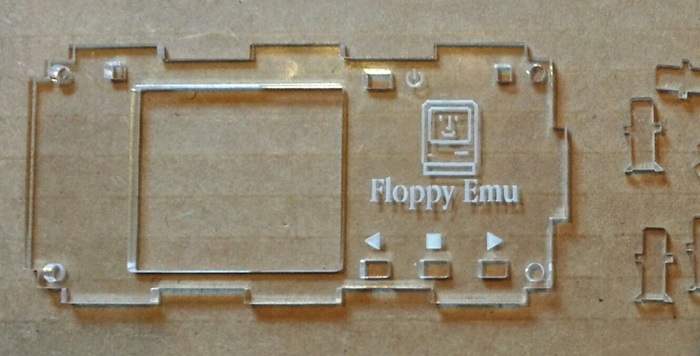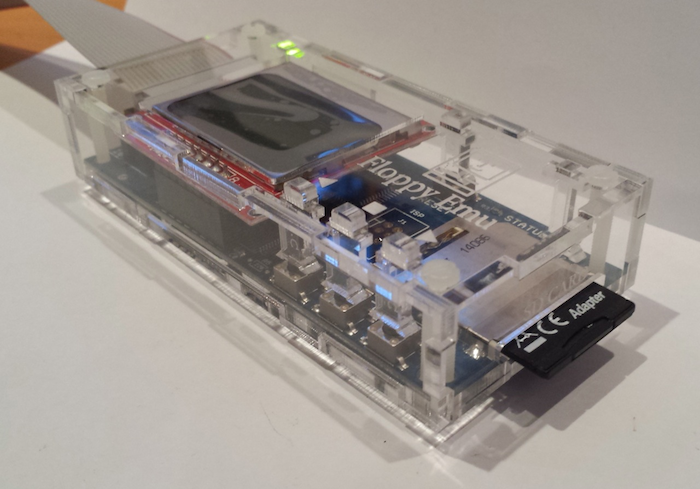Archive for November, 2015
Four Little Updates

Some brief updates on Floppy Emu, Plus Too, and the DiskCopy2Dsk tool:
Two Apple IIc Plus testers reported this week that the Floppy Emu disk emulator is incompatible in 3.5 inch emulation mode with that machine. If you’re not familiar with the IIc+, it’s an uncommon member of the Apple II family, and is a souped-up version of the more common IIc with an internal 3.5 inch floppy drive. While 5.25 inch disk emulation and Smartport hard disk emulation work fine with the IIc+, 3.5 inch emulation does not, for unknown reasons. Apparently the disk interface on the IIc+ differs from that on the IIgs and on the external Apple 3.5 Drive, which were the basis for Floppy Emu’s 3.5 inch Apple II emulation mode. Unfortunately IIc+ systems are fairly rare, and I don’t have one to test. If anyone has technical info on the IIc+ disk interface that they could share, please contact me.
A minor update of the Floppy Emu firmware for Lisa and Mac HD20 is available: hd20-0.7C-F14.5. This resolves an issue where a “fatal error: 0x96 sync” sometimes occurred during file copies in HD20 mode. Thanks to Joe Strosnider for reporting this issue and helping to text the fix. You can download the new firmware from the Floppy Emu page.
For anyone working with Macintosh DiskCopy 4.2 disk images, a bug was fixed in the command-line version of the dc2dsk tool. The tool converts DiskCopy 4.2 disk images into raw .dsk images with no header. Now that Floppy Emu directly supports DC42 image files, the tool isn’t necessary anymore, but if anyone’s used it for other purposes this will fix a bug in the image size calculation. For the curious, more info about why this tool was needed can be found here.
Magnus Karlsson has ported the Plus Too design to the Pipistrello FPGA board. Plus Too is a working hardware replica of the Macintosh Plus computer, originally developed by me in 2011. Recently Till Harbaum revived the project, ported it to the MiST FPGA board, and made major fixes and improvements. Magnus picked up the MiST code and adapted it to the Pipistrello board, where it’s still a work in progress but successfully boots to the Mac desktop. More info on this project is in the Saanmila discussion forum.
Be the first to comment!Oops! Laser Cut Material Thickness

Manufacturing is hard. The thickness of my supplier’s clear acrylic material has magically increased 15%, meaning that the latest batch of Floppy Emu acrylic cases are impossible to assemble. The buttons and light pipes don’t fit in the cut-outs made for them, so this entire batch of product will have to be thrown out. I’m hoping the supplier will agree to re-run my order or provide a refund, but I’m not optimistic since 15% is just within their stated tolerance. An expensive mistake in manufacturing for me!
For the past year, I’ve been offering laser-cut case enclosures as a Floppy Emu accessory, and I’ve sold hundreds of the cases to happy customers. They’re made from 3.0 mm (nominal) clear acrylic. With all of my past orders from the laser cutter, the parts I received had an actual thickness between 2.73 mm and 2.83 mm, and my design accounts for that. A case assembled from the old ~2.75 mm thick material looks like this:

I just received a new delivery of parts yesterday, and the material thickness changed to 3.15 mm! Imagine if you were building a house with 8 foot ceilings, but some of the framing lumber was over 9 feet – it would never work. That’s the same magnitude of change I’m facing now. The buttons and light pipes are cut from the same material as the case body, so now they’re 3.15 mm thick. But the cut-outs in the top of the case are only about 3.05 mm, and the parts won’t fit through. It’s still possible to assemble the six sides of the case, but without the buttons and light pipes it’s useless.
The supplier’s material thickness is rated at +/- 15%, so this is really my fault and not theirs. But +/- 15% is a huge margin. How am I supposed to make that work? If I make cut-outs big enough to accept 3.45 mm (+15%) thick buttons, but the actual material thickness in a future delivery is 2.55 mm (-15%), it’ll be so loose that buttons will just fall out. There’s no way I can see to accommodate a thickness tolerance that large.
Some of you may be thinking that I should never have made a design that relied on the material thickness as a critical parameter, and you’re right. But again, I’m not sure how I could have avoided it – any design where two parts meet at right angles with a tab-and-slot system will suffer from the same problem. For now, I’m faced with either re-cutting all the buttons and light pipes using thinner material if I can find some, or re-cutting all the case tops using bigger cut-outs.
Read 15 comments and join the conversation

